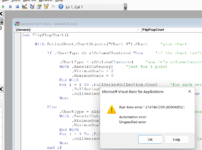Hello,
I have tables that correspond to 15 timepoints that automatically get updated based on values entered in source tables, and I have xy charts with dots that also automatically adapt to the tables.
Now, certain people in my organization only use the first time point (day 0) and have no need for the remaining time points. Since a bar chart is more suitable for one time point, I'm wondering whether I could use VBA to automatically change the chart type to a bar charts if only one time point appears in my tables? If possible, could someone let me know of the VBA code? This would be a really cool feature to add to my file .
.
Thanks for any input!
I have tables that correspond to 15 timepoints that automatically get updated based on values entered in source tables, and I have xy charts with dots that also automatically adapt to the tables.
Now, certain people in my organization only use the first time point (day 0) and have no need for the remaining time points. Since a bar chart is more suitable for one time point, I'm wondering whether I could use VBA to automatically change the chart type to a bar charts if only one time point appears in my tables? If possible, could someone let me know of the VBA code? This would be a really cool feature to add to my file
Thanks for any input!






